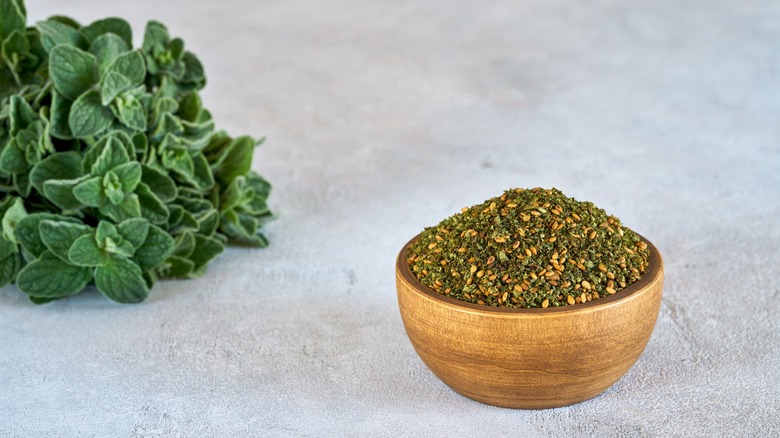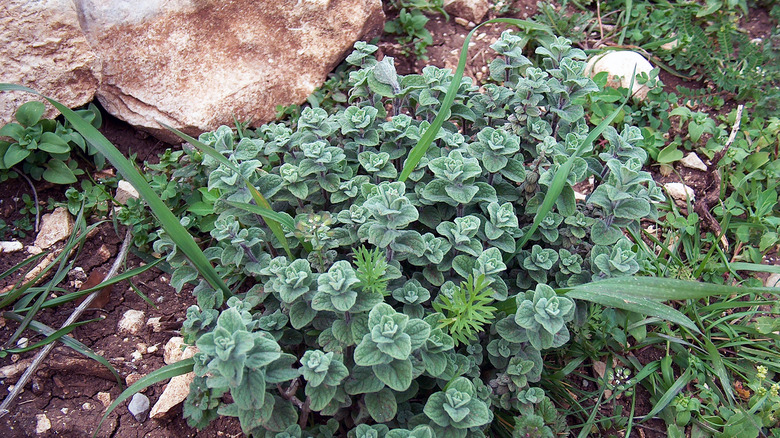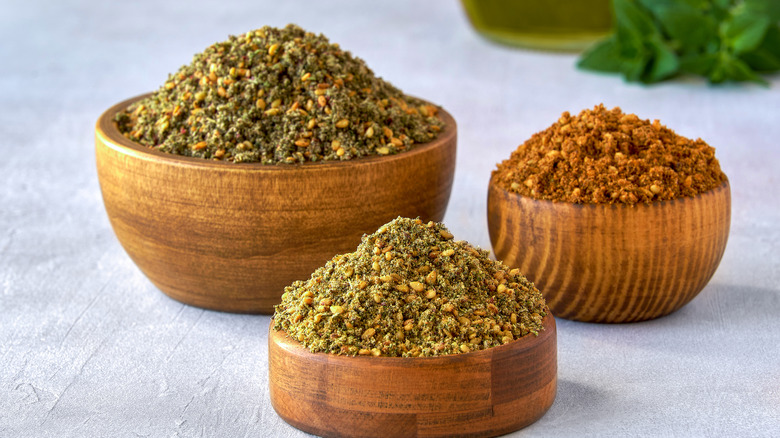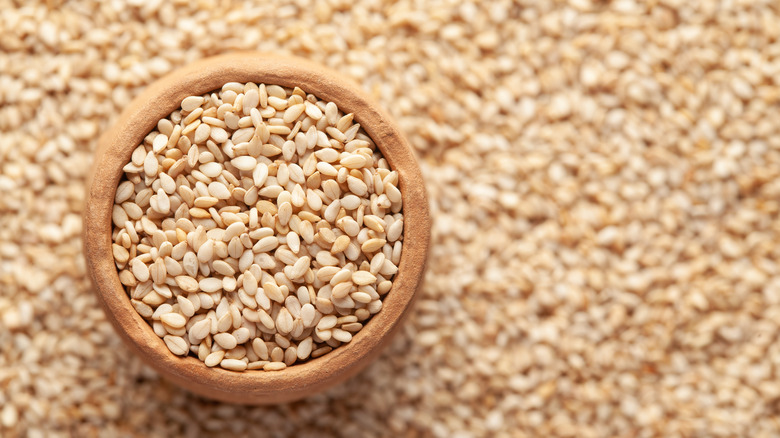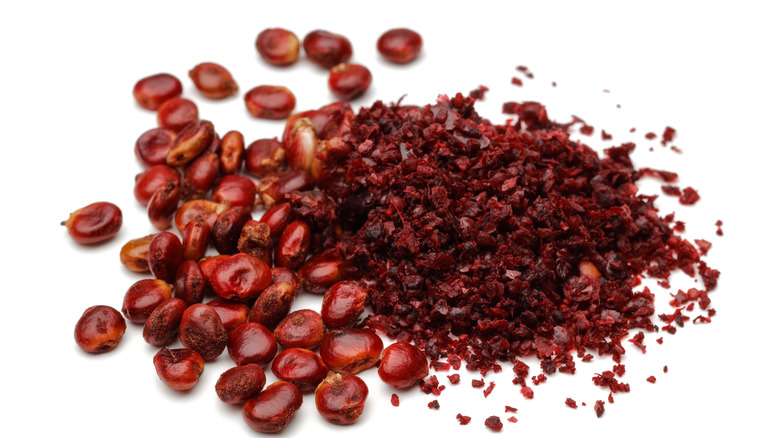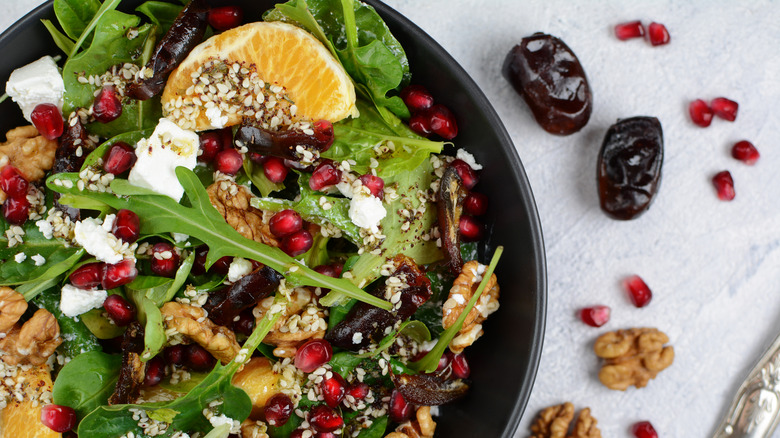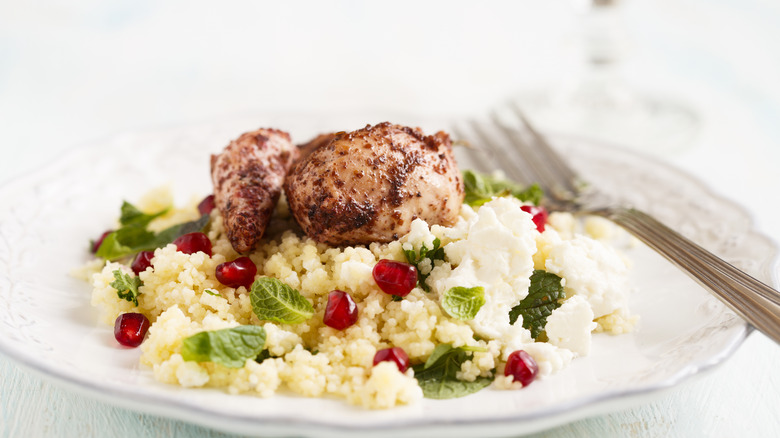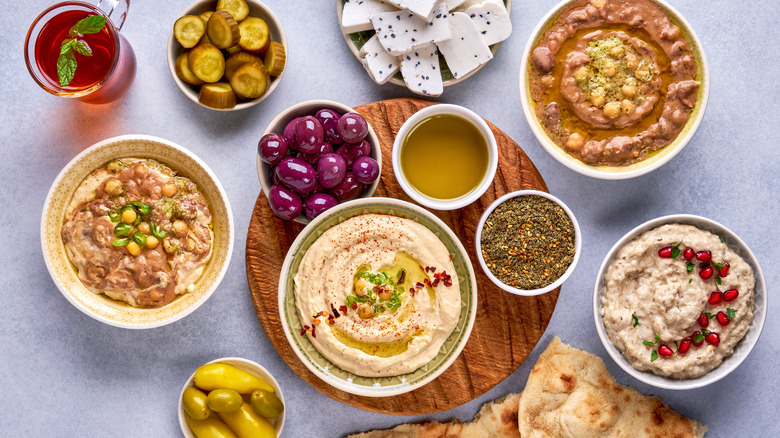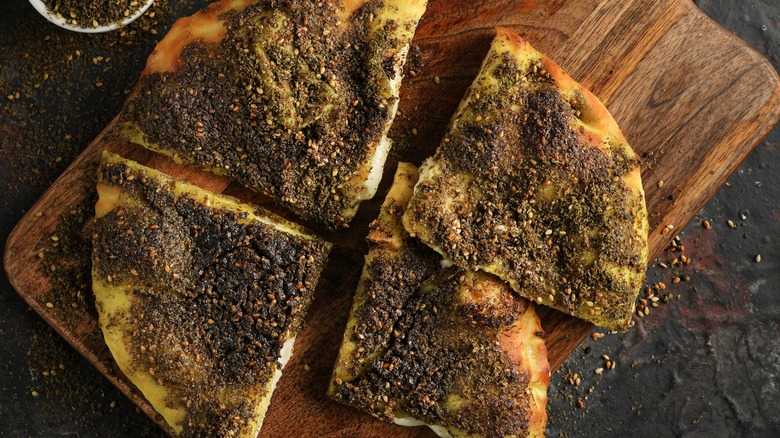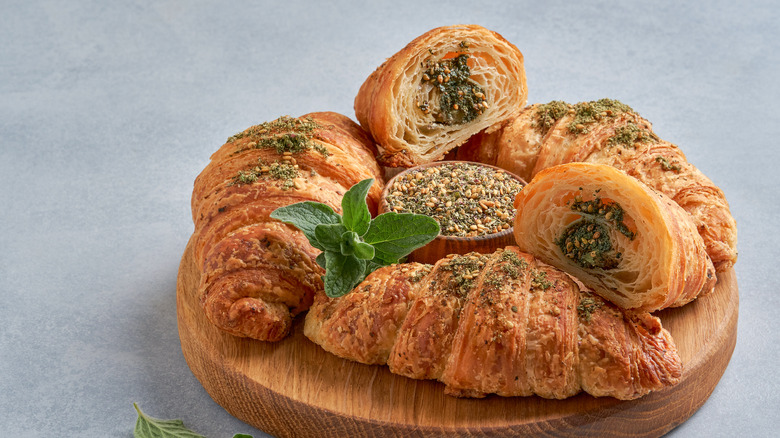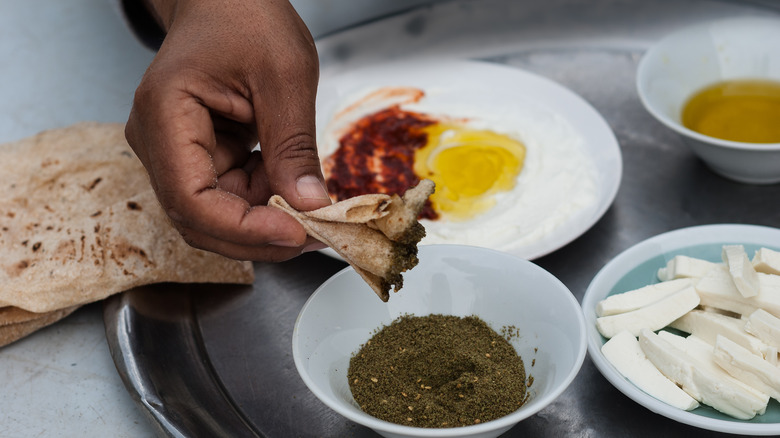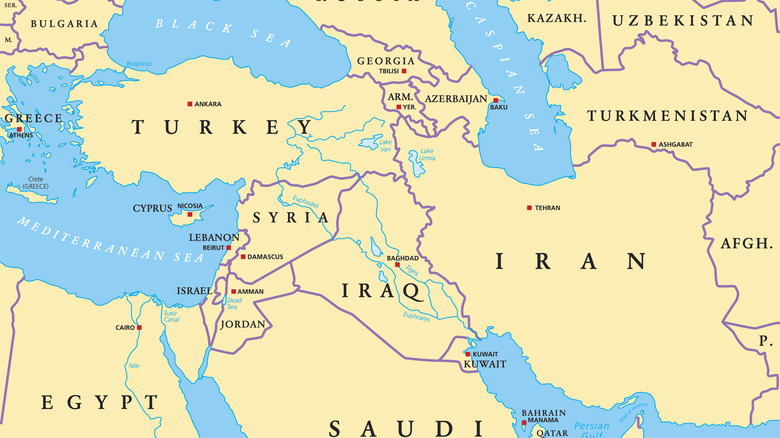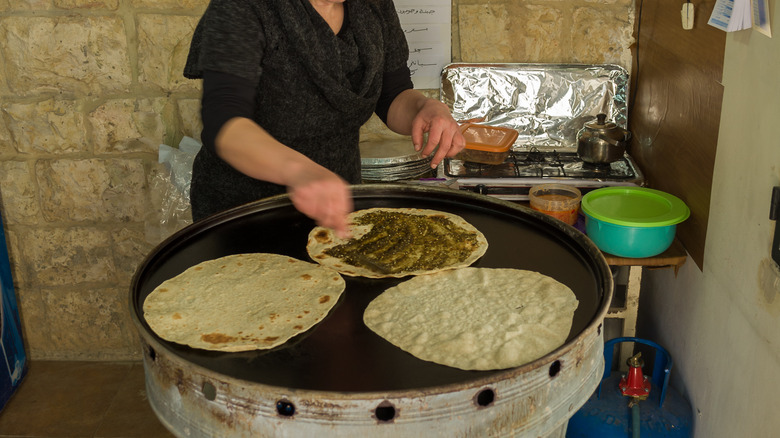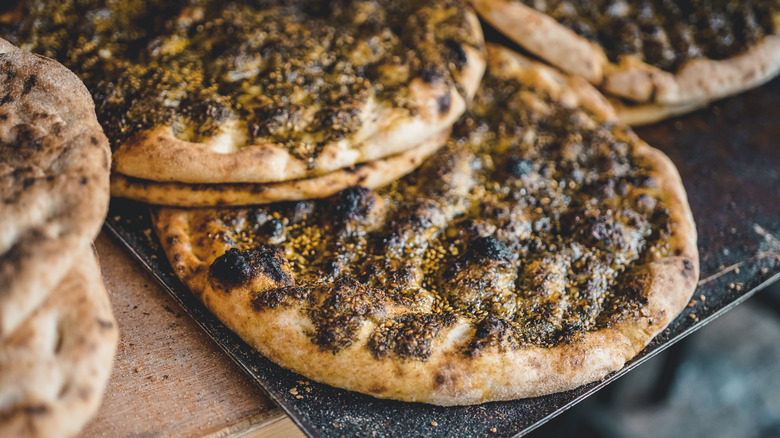13 Facts You Need To Know About Za'atar
Za'atar, as you know it, comes in a bottle or jar, ready to be added to rubs, salads, or eaten as a garnish on many dishes. But have you ever really thought about what za'atar is? It is a tangy, savory, and slightly crunchy topping from SWANA countries like Syria, Lebanon, and Jordan that brings a great zing of texture and flavor wherever it goes. When you hear herb mixture, you may immediately think of a powder, but that is not what real za'atar should resemble. Rather, a proper za'atar herb mixture should be coarser flakes of herb that look like the dried herbs were gently ground between your fingers until they crumbled, but just slightly.
Similar to many other types of herb mixes, such as masalas and curry powders, za'atar is exactly that, a mix. Za'atar is a combination of many herbs that are dried and then ground into dusty pieces before being mixed in carefully crafted ratios. Because za'atar is very common all across Southwest Asia and North Africa, there are many different types of za'atar with varying ingredients, including Syrian oregano, thyme, sesame seeds, marjoram, and sumac.
Za'atar is also the name of a plant
One of the main ingredients in a za'atar mixture is Syrian oregano. While you can use whatever oregano you have on hand, such as zingy Mexican oregano, the traditional ingredient in za'atar is Syrian oregano. This plant, which is also known as bible hyssop, also goes by the name za'atar.
Therefore, za'atar refers to both an herb and herb mixture. Syrian oregano originates from the SWANA region, so in authentic za'atar recipes, using Syrian oregano is a must. This special herb is famous for its earthy flavor, bringing warmth and gentle undertones of spice and peppermint to many dishes. While it is named both Syrian oregano and hyssop, the za'atar herb is technically part of the mint family, contributing to the fresh flavor it brings to dishes. Considering that the za'atar herb mixture is essentially named after the za'atar herb, it is evident that this specific herb is profoundly important to SWANA cuisine and culture. Throughout this article, we will refer to hyssop and Syrian oregano interchangeably, considering that they are the same plant, so make sure not to get confused.
The herb mixture includes thyme
Now that we know that za'atar is a herb mixture and a plant, let's discuss what goes into this mix. Besides beloved Syrian oregano, another huge player in a classic za'atar herb mixture is thyme. Some mixes claim this is essential, while others say that thyme is not a traditional addition. Thyme is another earthy and warm spice that grows well in Mediterranean and temperate climates. As the plant ages, it can become fairly woody, but regardless of its age, the small teeny tiny thyme leaves will still give off the same distinct flavor.
When you mix thyme and oregano in dishes such as shepherd's pie, the result is incredibly comforting and satisfying. In Za'atar, it is no different. Thyme and za'atar come together to create a wonderful duo of flavors that show how eating dried herbs can still be fantastically flavorful. While you can cook your za'atar in a sauce or marinade and simultaneously rehydrate it, once you try dry za'atar you will understand how flavorful it can be just on its own.
Don't forget about sesame seeds
Za'atar is famed for its slight crunch, which comes from delicious sesame seeds. Sesame seeds, an essential in many cuisines around the world, are delicious thanks to their high-fat content and natural nutty flavor. This nuttiness can be tasted in sesame oil, in sesame pastes like tahini, and in desserts with sesame like delicious black sesame ice cream.
In za'atar, sesame seeds are an essential addition. They bring a slight pop and crunch with every bite, and when you dip bread in olive oil and then za'atar, as is customary in many households, the crunchy, chewy, and oily combination that ensues is delightful. To further elevate your za'atar make sure to toast your sesame seeds. Toasted sesame seeds are exceptionally nutty, deeply flavorful, and even more delicious than raw ones. Once you have a stash of toasted sesame seeds on hand, you can use them as a garnish and condiment for many dishes. However, make sure to store your sesame seeds in the fridge or freezer because, like nuts, sesame seeds can go rancid easily due to their high-fat ratio.
It also has sumac
One final component of za'atar that is often seen as an essential addition to a za'atar mix is sumac. In za'atar, sumac comes in the form of a powder that is dark red and sometimes slightly orange. Sumac powder is the ground version of sumac berries which are berries that grow natively in the SWANA region. While yes, technically, sumac is a berry, it tastes nothing like the berries you may be used to, like blueberries or blackberries. Rather, sumac is tangy and acidic. It tastes slightly like lemon zest or vinegar thanks to its acidic notes and also boasts a strong earthy flavor that pairs well with the other herbs in a za'atar mix.
The slight acidity of sumac pairs very well with the other herbs in za'atar because it brings a zing of freshness to each bite. Without sumac, za'atar would be simply a mix of warm herbs, but with the addition of sumac, za'atar transforms into a tangy and layered condiment.
Za'atar can be used in salad dressing
Now that we know all about what za'atar is, in terms of both the mixture and the herb, it is time to talk about how you can use za'atar. This fantastic herb mixture goes well on top of many things and is so flavorful by itself that you can have it with simple starches like bread or rice, and it will make you a meal bursting with flavor.
One of the best ways to use za'atar is by having it in a salad dressing. The sumac in the za'atar mixture pairs beautifully with any other acid that you are adding to your dressing, such as vinegar or lemon juice. Furthermore, the slightly floral notes from the sumac will help elevate the other herbs in the mixture, especially once they are slightly hydrated from whatever you make your dressing with. If you are looking for an easy way to spruce up your favorite salad dressing, try tossing in a tablespoon of za'atar. Along with the sumac, the sesame seeds will also bring a nice gentle crunch to your salad and make the whole dish more cohesive and delicious.
Or as a rub
If you want to use za'atar in another way, consider using it as a rub. Like with other meat and protein rubs, za'atar adds a lot of flavor to your meats when they are marinating and cooking, so using a pre-determined delicious rub will be your best friend. You can use za'atar in your favorite chicken recipe as an easy yet divine way to bring flavor to your showstopping meals.
The combination of za'atar, thyme, sumac, and sesame seeds comes together in a way that makes a complete bite. The sumac's acid, the thyme's gentle earthiness, and the slight sweetness from the oregano or hyssop make za'atar the perfect seasoning. You can use za'atar as a dry rub by simply massaging it onto the skin of meat and letting it sit. You can also mix it with other marinades or braises. Za'atar pairs well with many other herbs and spices to partner perfectly with marinades made out of aromatics such as parsley, garlic, and paprika.
It makes a great all-purpose seasoning
Overall, no matter what you choose to use your za'atar in, it will bring a burst of flavor to your dishes. It is an incredibly versatile seasoning that can be the dash of flavor you need to liven your food. Have you ever thought about having za'atar with your pasta? Give it a try. The nuttiness from the sesame seeds goes very well with some lightly buttered or oiled pasta, and the warm oregano and thyme are just begging to be eaten with something starching and comforting.
You can also use za'atar as you would furikake. Za'atar is delicious when added to rice or soups, making each bite a flavor journey. Like furikake, a Japanese seasoning that often has bits of seaweed, sesame seeds, and salt, you can use za'atar on your roasted veggies or on top of your rice bowls. The expert combination of savory, acidic, and nutty makes za'atar an ideal garnish for many dishes and easy to bring texture and flavor to your meals.
But it is best simply with flatbread
At its heart, za'atar belongs with olive oil and flatbread. Sometimes, like with manakeesh, a flatbread that is commonly eaten in Lebanon and Syria, za'atar is mixed with a generous amount of olive oil and baked on top of the flatbread. The resulting manakeesh is utterly divine. The olive oil almost fries the thick layer of za'atar and transforms the previously vibrant za'atar into an irresistible and warm flavor that pairs perfectly with the oily and chewy bread.
Another very common way to eat za'atar is simply with olive oil and flatbread. Unlike manakeesh, this version is less labor intensive and can be eaten as a snack, for breakfast, or as a side dish. To eat za'atar this way, you simply tear off a piece of flatbread and roll it or fold it into a small, dippable piece. Then the first step is to dip the bread in oil and then next into the za'atar. Dipping the bread in this order enables the za'atar to adhere to the bread and create a speckled coating on your bread that is crunchy and flavorful when you pop the whole bite in your mouth.
Za'atar is nicknamed brain food
Za'atar has been nicknamed a brain food, and the reasons for this are multifaceted. To begin with, za'atar contains hyssop and thyme, which are both herbs with many health benefits. Oregano, according to Healthline, is high in antioxidants and is known to help with inflammation. Thyme, on the other hand, can help regulate your blood pressure or fight off acne (via Healthline). Both of these herbs, aside from tasting good, are also very beneficial for your body and will leave you feeling refreshed and nourished.
Along with having substantial amounts of oregano and thyme, which have the previously mentioned health benefits, za'atar contains sesame seeds. Sesame seeds are incredibly nutritious seeds, and the healthy fats and oils in sesame seeds may be another reason za'atar is famed for being a brain food. They are very high in protein and calcium and are also an excellent source of fiber, as per WebMD. Sesame seeds are so prized for their nutrition content, excellent taste, and beauty that they have been highly valued throughout history. In fact, at one point, sesame seeds were considered to be as, if not more, valuable than gold, thanks to their high demand and widespread love.
Za'atar has a rich history
Za'atar, both the herb blend and the plant, originate from SWANA and southern Europe, where the wild Syrian oregano grows prolifically. From this herb, za'atar was born, and thus the region rich with za'atar the herb, also became reliant on the herb blend. The history of both the herb and herb blend is deeply interlaced with the cultures in SWANA. For example, long ago, it was customary for za'atar to be used in cleansing or medicinal practices. It was also highly sought after by kings and pharaohs for its alluring aroma and irresistible taste.
Za'atar's history is long and rich but also largely undocumented. Because many of the za'atar makers and cooks were women who spent most of their time cooking and tending to the house, much of the lore around za'atar has been lost. However, it is still well agreed upon that za'atar has an incredibly rich history that can be traced back thousands of years, way back to ancient Egypt and the Bible. It is deeply culturally important to many of the Gulf and North African countries and is a staple pantry item in many households across the world.
Za'atar is from SWANA
Za'atar, both the herb and herb mixture, originates from the SWANA region, which stands for South West Asia and North Africa. In this region, the temperatures are often fairly temperate but can vary from having regular rainfall to being quite arid. Thankfully, za'atar, the plant, grows well in dry habitats and can withstand a variety of climates. Thanks to its woody nature, za'atar is both frost and drought-tolerant and can live year-round in the right circumstances.
Za'atar, the herb, has long grown widely in the SWANA region, and thanks to its robust nature, it has been resilient throughout many shifts this region has undergone throughout history. Thanks to its long history in this region, it is fully understandable that za'atar plays an integral part in the cultures of this region. It has long been used in the cuisines and celebrations in many cultures, and its importance can be tasted in many dishes, as well as in the famous herb mixture that goes by the same name, za'atar.
Za'atar is mentioned in the Bible
Za'atar has been important and beloved in the SWANA region for so long that it is even mentioned in the Bible. Throughout the Bible, specifically in the Book of Exodus, followers are told to use hyssop to cleanse their homes and lives. You may be thinking, hyssop is not in Za'atar, but in fact, it is. Some claim that true za'atar is made with hyssop rather than oregano, and it is thanks to the herby and slightly mint flavor of the hyssop that za'atar blends taste so lovely.
Hyssop, also known as Bible hyssop, is an essential component of za'atar. But the distinction can be confusing. Because hyssop is also known as Syrian oregano, and oregano is also known as oregano, authentic za'atar has many definitions. In general, za'atar requires some component of hyssop or Syrian oregano, and it is this specific herb that is referred to several times in the Bible and, thus, has played a large role in many rituals, celebrations, and cultures throughout history.
Za'atar day is September 23
If you love za'atar, or are ready to try it after reading this article, then you will be happy to know that za'atar has a whole day dedicated to it. International za'atar day was created as a way to celebrate this wild herb that has a large influence on the cuisines and cultures of the Arab and SWANA world. You can look forward to celebrating za'atar Day at the end of every summer on September 23.
Za'atar Day is a great time to look more into the history of this fascinating herb and truly begin to appreciate how much influence and importance both the herb and herb blend has. You can trace za'atar back throughout history and see that it has been used in ritual cleanses, air purification, and even to mummify bodies. It is, therefore evident, that za'atar is useful for so much more than eating, so next time you are munching on some za'atar, make sure to appreciate its origins.
Static Media owns and operates Tasting Table and Mashed.
